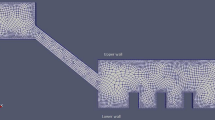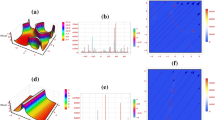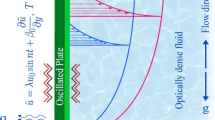Abstract
The general two-phase debris flow model proposed by Pudasaini (J. Geophys. Res. 117:F03010, 2012, doi:10.1029/2011JF002186) is employed to simulate subaerial and submarine two-phase debris flows and the mechanics of complex wave generation and interactions between the solid and the fluid phases. This includes the fluid waves or the tsunami generated by the debris impact at reservoirs, lakes, and oceans. The analysis describes the generation, amplification, and propagation of super tsunami waves and run-ups along coastlines, debris slide and deposition at the bottom floor, and debris shock waves. Accurate and advance knowledge of the arrival of tsunami waves in the coastal regions is very important for the design of early warning strategies. Here, we show that the amount of solid grain in the fluid reservoir plays a significant role in controlling the overall dynamics of the submarine debris flow and the tsunami. For very small solid particle concentrations in the reservoir, the submarine debris flow moves significantly faster than the surface tsunami wave. As the solid volume fraction in the reservoir increases, the submarine debris speed slows down. For relatively large solid volume fractions in the reservoir, the speed of the submarine debris becomes slower than the surface tsunami wave. This information can be useful for early warning strategies in the coastal regions. The fast or slow speed of the submarine wave can be attributed to several dynamical aspects of the model including the generalized drag, basal traction, pressure gradient, virtual mass force, the non-Newtonian viscous stress, and the strong phase interaction between the solid and the fluid as they enhance or diminish the motion of the solid phase. Solid particle concentration in the reservoir dam also substantially influences the interaction between the submarine debris flow and the frontal wall of the dam, and the interaction between the tsunami and the submarine debris wave. The tsunami wave impact generates a largely amplified fluid level at the dam wall. Submarine debris shock waves are observed for small solid volume fractions in the reservoir. Another important aspect of the simulation is to investigate the complex interactions between the internal submarine debris wave and the surface tsunami wave. Three complex waves occur simultaneously: the subaerial debris flow in the upstream region, submarine debris flow in the reservoir basin, and a super tsunami wave on the surface of the reservoir. This helps to develop insight into the basic features of the complex nonlinear solid and fluid waves and their interactions.
Similar content being viewed by others
References
Abadie S., Morichon D., Grilli S., Glockner S.: Numerical simulation of waves generated by landslides using a multiple-fluid Navier–Stokes model. Coast. Eng. 57(9), 779–794 (2010)
Abele G.:Kinematik und Morphologie spät- und postglazialer Bergstürze in den Alpen. Z. Geomorph. N.F. Suppl.Bd. 14, 138–149 (1972)
Antobreh A.A., Krastel S.: Mauritania Slide Complex: morphology, seismic characterisation and processes of formation. Int. J. Earth Sci. (Geol. Rundsch.) 96, 451–472 (2007). doi:10.1007/s00531-006-0112-8
Cecioni C., Bellotti G.: Inclusion of landslide tsunamis generation into a depth integrated wave model. Nat. Hazards Earth Syst. Sci. 10, 2259–2268 (2010)
Domnik B., Pudasaini S.P.: Full two-dimensional rapid chute flows of simple viscoplastic granular materials with a pressure-dependent dynamic slip-velocity and their numerical simulations. J. Non-Newtonian Fluid Mech. 173–174, 72–86 (2012)
Domnik B., Pudasaini S.P., Katzenbach R., Miller S.A.: Coupling of full two-dimensional and depth-averaged models for granular flows. J. Non-Newtonian Fluid Mech. 201, 56–68 (2013)
Fernandez-Nieto E.D., Bouchut F., Bresch D., Castro Diaz M.J., Mangeney A.: A new Savage–Hutter type model for submarine avalanches and generated tsunami. J. Comput. Phys. 227, 7720–7754 (2008)
Fine, I.V., Rabinovich, A.B., Bornhold, B.D., Thomson, R.E., Kulikov, E.A.: The Grand banks landslide generated tsunami of November 18, 1929: preliminary analysis and numerical modeling. Mar. Geol. 215, 45–57 (2005)
Fischer J.T., Kowalski J., Pudasaini S.P.: Topographic curvature effects in applied avalanche modeling. Cold Reg. Sci. Tech. 74-75, 21–30 (2012)
Foerster A., Ellis R.G., Henrich R., Krastel S., Kopf A.J.: Geotechnical characterization and strain analyses of sediment in the Mauritania Slide Complex, NW-Africa. Mar. Pet. Geol. 27, 1175–1189 (2010)
Geersen J., Voelker D., Behrmann J.H., Reichert C., Krastel S.: Pleistocene giant slope failures offshore Arauco Peninsula, Southern Chile. J. Geol. Soc. Lond. 168, 1–12 (2011). doi:10.1144/0016-76492011-027
George, D.L., Iverson, R.M.: A two-phase debris-flow model that includes coupled evolution of volume fractions, granular dilatancy, and pore-fluid pressure. Italy J. Eng. Geol. Environ. (2011). doi:10.4408/IJEGE.2011-03.B-047
Georgiopoulou A., Masson D.G., Wynn R.B., Krastel S.: Sahara slide: age, initiation, and processes of a giant submarine slide. Geochem. Geophys. Geosyst. 11, Q07014 (2010). doi:10.1029/2010GC003066
Haflidason H. et al.: A weak layer feature on the Northern Storegga Slide escarpment. In: Mienert, J., Weaver, P. (eds) European Margin Sediment Dynamics, Side-Scan Sonar and Seismic Images, pp. 55–62. Springer, Berlin (2003)
Harbitz C.B., Lovholt F., Pedersen G., Masson D.G.: Mechanisms of tsunami generation by submarine landslides: a short review. Norw. J. Geol. 86(3), 255–264 (2006)
Haugen K.B., Lovholt F., Harbitz C.B.: Fundamental mechanisms for tsunami generation by submarine mass flows in idealised geometries. Mar. Pet. Geol. 22(1–2), 209–217 (2005)
Henkel S. et al.: An interdisciplinary investigation of a recent submarine mass transport deposit at the continental margin off Uruguay. Geochem. Geophys. Geosyst. 12, Q08009 (2011). doi:10.1029/2011GC003669
Henrich R., Hanebuth T., Krastel S., Neubert N., Wynn R.B.: Architecture and sediment dynamics of the Mauritania Slide Complex. Marine Petrol. Geol. 25, 17–33 (2008)
Iverson R.M., Denlinger R.P.: Flow of variably fluidized granular masses across three-dimensional terrain: 1. Coulomb mixture theory. J. Geophys. Res. 106(B1), 537–552 (2001)
Jerz H., Poschinger A.V.: Neuere Ergebnisse zum Bergsturz Eibsee-Grainau. Geologica Bavarica 99, 383–398 (1995)
Kowalski J., McElwaine J.N.: Shallow two-component gravity-driven flows with vertical variation. J. Fluid Mech. 714, 434–462 (2013)
Krastel S., Scminke H.U., Jacobs C.L., Rihm R., Le Bas T.P., Alibes B.: Submarine landslides around the Canary Islands. J. Geophys. Res. 106, 3977–3997 (2001)
Krastel, S.: Cruise Participants: Report and Preliminary Results of Meteor Cruise M 65/2, Dakar-Las Palmas 04.07.–26.07.2005, Berichte, Fachbereich Geowissenschaften, Universitaet Bremen, p. 249 (2006)
Liu P.L.F., Wu T.R., Raichlen F., Synolakis C.E., Borrero J.C.: Runup and rundown generated by three-dimensional sliding masses. J. Fluid Mech. 536(1), 107–144 (2005)
Masson, D.G., Harbitz, C.B., Wynn, R.B., Pedersen, G., Lovholt, F.: Submarine landslides: processes, triggers and hazard prediction. Phil. Trans. R. Soc. A 364, 2009–2039 (2006)
Martinez M.L. et al.: The coasts of our world: ecological, economic and social importance. Ecol. Econ. 63, 254–272 (2007)
Maxey R.M., Riley J.J.: Equation of motion for a small sphere in a non-uniform flow. Phys. Fluids 26, 883–889 (1993)
McAdoo B.G., Watts P.: Tsunami hazard from submarine landslides on the Oregon continental slope. Marine Geol. 203, 235–245 (2004)
Mergili M., Schratz K., Ostermann A., Fellin W.: Physically-based modelling of granular flows with Open Source GIS. Nat. Hazards Earth Syst. Sci. 12, 187–200 (2012)
Miller Don, J.: Giant Waves in Lituya Bay, Alaska. Geological Survey Professional Paper 354-C, U.S. Government Printing Office, Washington (1960)
Miller L.: The rock slide in the Vajont Valley. Rock Mech. Eng. GeoZ. 2(3–4), 148–212 (1964)
Mohammed, F., Fritz, H.M.: Experiments on tsunamis generated by 3D granular landslides. In: Mosher, D.C. et al.(eds.) Submarine Mass Movements and Their Consequences, 4th International Symposium. Advances in Natural andTechnological Hazards Research, vol. 28, pp. 705–718. Springer, New York (2010)
Montagna F., Bellotti G., Di Risio M.: 3D numerical modeling of landslide-generated tsunamis around a conical island. Nat. Hazards 58(1), 591–608 (2011)
Nessyahu H., Tadmor E.: Non-oscillatory central differencing for hyperbolic conservation laws. J. Comput. Phys. 87, 408–463 (1990)
Pierau R., Hanebuth T.J.J., Krastel S., Henrich R.: Late Quaternary climatic events and sea-level changes recorded by turbidite activity, Dakar Canyon, NW Africa. Quat. Res. 73, 385–392 (2010)
Pierau R., Henrich R., Preiss-Daimler I., Krastel S., Geersen J.: Sediment transport and turbidite architecture in the submarine Dakar Canyon off Senegal, NW-Africa. J. Afr. Earth Sci. 60, 196–208 (2011)
Pitman E.B., Le L.: A two-fluid model for avalanche and debris flows. Philos. Trans. R. Soc. A363, 1573–1602 (2005)
Pudasaini S.P., Hutter K.: Rapid shear flows of dry granular masses down curved and twisted channels. J. Fluid Mech. 495, 193–208 (2003)
Pudasaini S.P., Wang Y., Hutter K.: Modelling debris flows down general channels. Nat. Hazards Earth Syst. Sci. 5, 799–819 (2005)
Pudasaini S.P., Hutter K.: Avalanche Dynamics: Dynamics of Rapid Flows of Dense Granular Avalanches, pp. 602. Springer, New York (2007)
Pudasaini S.P., Kröner C.: Shock waves in rapid flows of dense granular materials: theoretical predictions and experimental results. Phys. Rev. E 78, 041308 (2008). doi:10.1103/PhysRevE.78.041308
Pudasaini S.P.: Some exact solutions for debris and avalanche flows. Phys. Fluids 23(4), 043301 (2011)
Pudasaini, S.P.: A general two-phase debris flow model. J. Geophys. Res. 117, F03010. (2012). doi:10.1029/2011JF002186
Pudasaini S.P., Miller S.A.: Buoyancy induced mobility in two-phase debris flow. Am. Inst. Phys. Proc. 1479, 149–152 (2012a). doi:10.1063/1.4756084
Pudasaini S.P., Miller S.A.: A real two-phase submarine debris flow and tsunami. Am. Inst. Phys. Proc. 1479, 197–200 (2012b). doi:10.1063/1.4756096
Pudasaini, S.P., Miller, S.A.: The hypermobility of huge landslides and avalanches. Eng. Geol. (2013). doi:10.1016/j.enggeo.2013.01.012
Rivero M., Magnaudet J., Fabre J.: Quelques resultants nouveaux concernat les forces exercees sur une inclusion spherique par un ecoulement accelere. C. R. Acad. Sci. Ser. II 312, 1499–1506 (1991)
Savage S.B., Hutter K.: The motion of a finite mass of granular material down a rough incline. J. Fluid Mech. 199, 177–215 (1989)
Takahashi T.: Debris Flow: Mechanics, Prediction and Countermeasures. Taylor & Francis, London (2007)
Tai Y.-C., Noelle S., Gray J.M.N.T., Hutter K.: Shockcapturing and front-tracking methods for granular avalanches. J. Comput. Phys. 175, 269–301 (2002)
Tinti S., Armigliato A., Manucci A., Pagnoni G., Zaniboni F., Yalciner A.C., Altinok Y.: The generating mechanisms of the August 17 1999 Izmit bay (Turkey) tsunami: Regional (tectonic) and local (mass instabilities) causes. Marine Geol. 225, 311–330 (2006)
Tinti S., Manucci A., Pagnoni G., Armigliato A., Zaniboni F.: The 30 December 2002 landslide-induced tsunamis in Stromboli: sequence of the events reconstructed from the eyewitness accounts. Nat. Hazards Earth Syst. Sci. 5, 763–775 (2005)
Watts P., Grilli S.T., Tappin D.R., Fryer G.J.: Tsunami generation by submarine mass failure. II: predictive equations and case studies. J. Waterw. Port Coast. Ocean Eng. 131(6), 298–310 (2005)
Weiss R., Fritz H.M., Wuennemann K.: Hybrid modeling of the mega-tsunami runup in Lituya Bay after half acentury. Geophys. Res. Lett. 36, L09602 (2009). doi:10.1029/2009GL037814
Author information
Authors and Affiliations
Corresponding author
Rights and permissions
About this article
Cite this article
Pudasaini, S.P. Dynamics of submarine debris flow and tsunami. Acta Mech 225, 2423–2434 (2014). https://doi.org/10.1007/s00707-014-1126-0
Received:
Revised:
Published:
Issue Date:
DOI: https://doi.org/10.1007/s00707-014-1126-0




